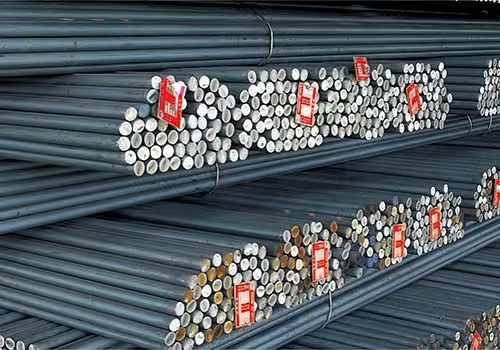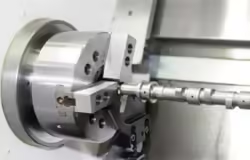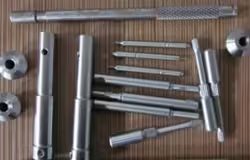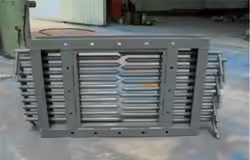
Everything You Need to Know About E195 Steel
E195 steel is a low-alloy, high-strength material that has become a preferred choice in construction, industrial machinery, and infrastructure projects. Its balanced combination of strength, ductility, and weldability makes it versatile for a variety of applications, ranging from load-bearing supports in buildings to bridge girders and heavy-duty industrial frames. Understanding its properties, applications, and best practices for use can help engineers, architects, and procurement managers make informed decisions
Table of Contents
Understanding E195 Steel and Its Key Characteristics

E195 steel is a low-alloy, high-strength material widely used in construction, industrial machinery, and infrastructure projects. Its combination of tensile strength, ductility, and weldability makes it highly versatile for applications ranging from load-bearing supports in buildings to bridge girders and industrial frames. Understanding its chemical composition, mechanical performance, and practical applications enables engineers and procurement professionals to make informed decisions for both safety and efficiency.
Understanding E195 Steel and Its Key Characteristics
E195 steel is engineered to achieve a balance between strength and toughness. Unlike standard carbon steels, which can be brittle under heavy or dynamic loads, E195 provides superior load-bearing capacity while remaining flexible enough to absorb shocks and vibrations. This makes it ideal for structural supports in buildings, bridges, and machinery frames.
The steel’s moderate carbon content ensures both strength and weldability. Alloying elements such as manganese enhance toughness, enabling the steel to resist impact forces, while silicon increases elasticity and improves resistance to wear. This combination allows E195 steel to be used in environments requiring both durability and flexibility.
Real-World Case Example:
During the construction of a multi-story commercial complex in Shanghai, E195 steel columns were selected for the internal support framework. The steel’s weldability allowed efficient on-site assembly, and its strength enabled the structure to withstand dynamic loads from construction equipment and temporary scaffolding without structural compromise. Similarly, a manufacturing facility in Guangdong used E195 steel frames to support heavy machinery. The frames maintained integrity under continuous operational stress, demonstrating the material’s reliability and durability.
Chemical Composition and Why It Matters

The performance of E195 steel is largely determined by its chemical makeup. Key elements include carbon, manganese, silicon, phosphorus, and sulfur. Each of these elements plays a crucial role in achieving the desired mechanical properties. For instance, carbon contributes to hardness and tensile strength, while manganese improves toughness. Silicon increases elasticity and enhances overall strength, and controlled phosphorus and sulfur levels prevent brittleness and improve machinability.
A clear understanding of the chemical composition allows engineers to predict how the steel will behave under stress and choose the right grade for specific projects. Below is a comparative overview of E195 steel and some commonly used structural steels to highlight differences:
| Steel Type | Carbon (%) | Manganese (%) | Tensile Strength (MPa) | Weldability | Typical Applications |
|---|---|---|---|---|---|
| E195 Steel | 0.18–0.22 | 0.50–0.80 | 420–550 | Good | Supports, columns, industrial frames |
| E200 Steel | 0.20–0.25 | 0.60–0.90 | 450–580 | Moderate | High-strength beams, industrial machinery |
| Standard Carbon Steel | 0.15–0.20 | 0.30–0.60 | 350–450 | Excellent | General construction, non-critical structures |
This table demonstrates that E195 steel strikes a practical balance between strength and weldability, making it highly adaptable for both construction and industrial applications.
Mechanical Properties and Performance
E195 steel demonstrates a highly desirable combination of yield strength, tensile strength, and ductility, making it suitable for applications that require both load-bearing capacity and flexibility. Typically, its tensile strength ranges from 420 to 550 MPa, while yield strength is around 250 to 350 MPa, depending on thickness and processing. This allows the steel to withstand substantial static and dynamic loads without permanent deformation.
The steel’s ductility ensures that it can bend or flex under stress rather than crack, a property critical in structural supports that face uneven loads or vibrations. This behavior is particularly advantageous in earthquake-prone areas or in machinery bases that experience dynamic forces.
When compared to E200 steel, E195 offers slightly lower tensile strength but significantly better weldability and cost-effectiveness, making it more suitable for on-site assembly or projects with budget constraints. Compared with standard carbon steel, E195 provides superior toughness, wear resistance, and resistance to deformation, ensuring reliability for high-demand structural applications.
Engineering Insight:
Parameters such as elongation at break, impact toughness, and hardness are important when evaluating E195 steel for specific projects. For instance, typical elongation values of 20–25% indicate excellent flexibility, while impact toughness values ensure resilience under sudden loads.
Real-World Applications

E195 steel has been successfully applied across construction, industrial, and infrastructure projects:
High-Rise Construction
In a Shanghai commercial building project, E195 steel columns formed the internal support framework. The steel’s weldability allowed precise on-site assembly, and its high load resistance ensured structural stability during construction and under operational load.
Industrial Machinery Frames
A Guangdong-based manufacturing facility used E195 steel for heavy machinery frames and conveyor support structures. The steel maintained structural integrity under continuous operational stress, reducing maintenance requirements while ensuring safety.
Infrastructure and Bridge Supports
In infrastructure projects, E195 steel is applied in bridge girders and support columns. Its combination of strength and flexibility allows it to resist both static weight and dynamic traffic loads, ensuring long-term performance.
Conceptual Note
By analyzing real-life projects, engineers can determine the optimal grade, thickness, and processing method for E195 steel to match load requirements and environmental conditions.
Processing and Fabrication Considerations
E195 steel can be fabricated through hot-rolling and cold-rolling. Hot-rolled steel offers enhanced ductility and reduced residual stress, which is important for heavy structural members. Cold-rolled components provide tight dimensional tolerances for precision applications, such as machinery frames or industrial supports.
Welding E195 steel is straightforward for most sections. However, for thicker elements, preheating and post-weld heat treatment are recommended to prevent cracking and ensure mechanical integrity. Standard industrial cutting tools can be used, but careful edge finishing preserves the steel’s mechanical properties.
Practical Tip:
Understanding the interaction between processing methods and mechanical performance allows engineers to predict stress behavior, fatigue resistance, and long-term durability of E195 steel components.
Maintenance and Longevity
Proper maintenance enhances E195 steel’s lifespan. For outdoor applications or humid environments, applying corrosion-resistant coatings such as epoxy or galvanization is essential. Routine inspections detect early signs of wear, deformation, or corrosion, preventing unexpected failures.
Avoiding overloads beyond the steel’s yield strength and ensuring correct installation practices further contribute to structural reliability. Maintenance strategies should consider environmental exposure, load frequency, and potential vibration or impact forces.
Selecting E195 Steel: A Practical Buying Guide
Choosing the right E195 steel requires evaluating thickness, grade, supplier credibility, and compliance with standards. Thickness and grade should align with the intended load-bearing capacity and environmental conditions. Suppliers should provide mill test reports (MTRs) and quality certifications to confirm compliance with national or international standards.
Price is also an important factor. E195 steel is more cost-effective than higher-grade alloys while offering a balance of strength, toughness, and weldability. Comparing prices from certified suppliers and ensuring quality documentation reduces procurement risks.
Buying Insight:
Creating a procurement checklist that includes thickness, grade, certification, and price comparison allows project teams to make informed decisions and ensures reliable material supply.
Standards and Certifications for E195 Steel
E195 steel is manufactured to comply with a combination of domestic and international standards, ensuring mechanical and chemical properties meet rigorous requirements for structural applications. In China, GB/T 1591 specifies the requirements for low-alloy high-strength steel, including chemical composition limits, tensile strength, yield strength, and elongation. Compliance with this standard guarantees that E195 steel can perform reliably in construction, industrial, and infrastructure projects within the domestic market.
Beyond China, many projects require adherence to international standards. The ASTM A36/A572 standards in the United States provide guidelines for low-alloy structural steels with specific mechanical properties suitable for beams, columns, and machinery frames. Similarly, the EN 10025 standard in Europe defines requirements for structural steels, including chemical composition, mechanical testing, and certification procedures. Projects in regions such as the Middle East, Southeast Asia, and Australia often refer to these standards when importing steel, ensuring global compatibility and quality assurance.
Quality Assurance in Practice
To ensure reliability, verified suppliers of E195 steel should provide mill test reports (MTRs), production quality certificates, and compliance documentation. These documents allow engineers and procurement teams to confirm that the steel has undergone standardized testing for chemical composition, mechanical properties, and dimensional accuracy. Following recognized standards ensures consistent performance, structural safety, and long-term reliability, particularly in high-demand applications such as high-rise construction, heavy machinery, and bridges.
Regional Considerations
- In Europe, EN 10025 compliance is often a prerequisite for infrastructure and industrial projects.
- In the US, ASTM certification is critical for federal projects and high-load structural applications.
- Southeast Asian projects may require dual compliance with GB/T 1591 and local building codes to meet both domestic and international regulations.
Understanding these standards and certifications allows project teams to select E195 steel confidently, ensuring it meets both engineering requirements and regulatory compliance across different countries and regions.
Market Trends and Pricing Insights

The global demand for E195 steel has been steadily increasing, driven by urbanization, industrial expansion, and infrastructure development. In China, the ongoing high-rise construction boom and rapid industrialization continue to fuel demand for structural steels, including E195, due to its strength, toughness, and cost-effectiveness. Similarly, Southeast Asian countries such as Vietnam, Thailand, and Malaysia are seeing rising demand for E195 steel in industrial machinery and building construction as their manufacturing and infrastructure sectors expand.
Regional Price Dynamics
E195 steel pricing is influenced by a combination of global steel market trends, raw material costs, import-export tariffs, and regional supply-demand balances. In Europe, prices are affected by international scrap metal prices and energy costs in steel production. In North America, fluctuations in iron ore and production capacity can impact local E195 steel availability and cost. Within China, local supply constraints, transportation, and demand from high-rise construction and infrastructure projects contribute to regional price variations.
Market Analysis and Strategic Insights
Procurement teams benefit from monitoring E195 steel market trends to optimize budgets, plan project timelines, and secure material supply. Awareness of industry growth patterns—such as urban construction projects, industrial automation, and infrastructure expansion—enables companies to anticipate future demand and avoid supply shortages. For example, in regions like Guangdong and Jiangsu in China, where industrial facilities are rapidly expanding, securing E195 steel ahead of peak construction periods can prevent delays and cost overruns.
Global Demand Outlook
The balance of strength, weldability, and cost efficiency makes E195 steel a preferred choice worldwide. Analysts predict continued growth in demand, especially for construction, heavy machinery frames, and bridge supports. Projects in the Middle East and Africa increasingly use imported E195 steel that meets both GB/T 1591 and ASTM or EN standards to ensure quality and reliability.
Practical Tip for Buyers
Staying informed on market trends and regional pricing allows procurement teams to negotiate better deals, ensure timely deliveries, and plan long-term projects efficiently. Regularly reviewing supplier price updates, global steel indices, and regional demand forecasts is critical for cost-effective and reliable material procurement.
Conclusion
E195 steel is a practical, high-strength material suitable for a variety of construction, industrial, and infrastructure projects. Its combination of strength, ductility, and weldability allows for reliable performance across diverse applications. Real-world projects demonstrate that E195 steel provides both durability and cost-effectiveness when chosen and processed correctly.
Need specific selection advice or project consultation? Contact us today to discuss your requirements and get professional guidance on choosing the right E195 steel solution for your project.
FAQ
What is E195 steel used for?
E195 steel is used for structural supports, industrial machinery frames, bridge girders, and other load-bearing applications. Its combination of strength and flexibility makes it versatile.
Can E195 steel be welded safely?
Yes, E195 steel can be welded using standard methods. Preheating and post-weld heat treatment are recommended for thicker sections to prevent cracking and preserve strength.
How does E195 compare with other steels like E200 or carbon steel?
E200 steel has slightly higher strength but is less cost-effective and harder to weld. Carbon steel is cheaper but lacks toughness and is more prone to deformation under load.
How do I select the right thickness and grade?
Selection depends on load requirements, weldability, and environmental factors. Consulting supplier specifications and engineering tables is recommended.
What maintenance is required for E195 steel in outdoor environments?
Apply corrosion-resistant coatings and perform regular inspections. Avoid overloading the steel to ensure long-term durability.






